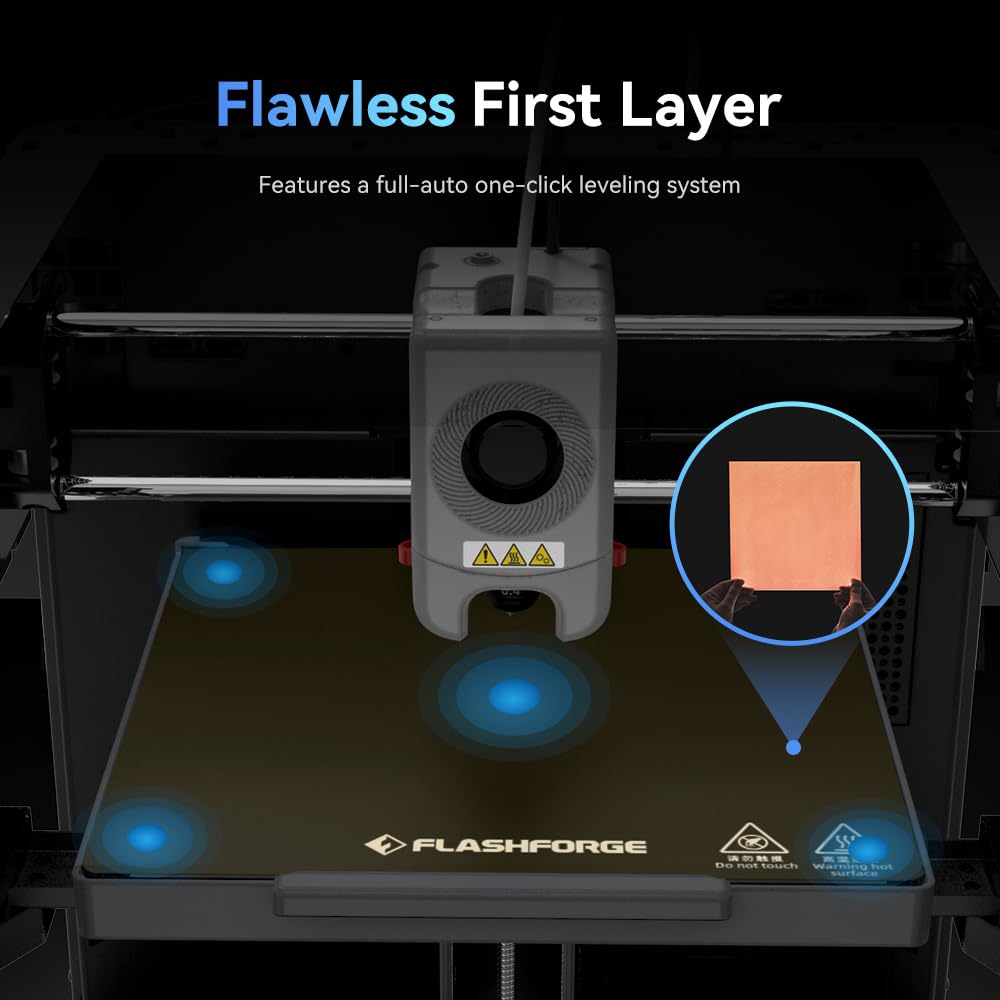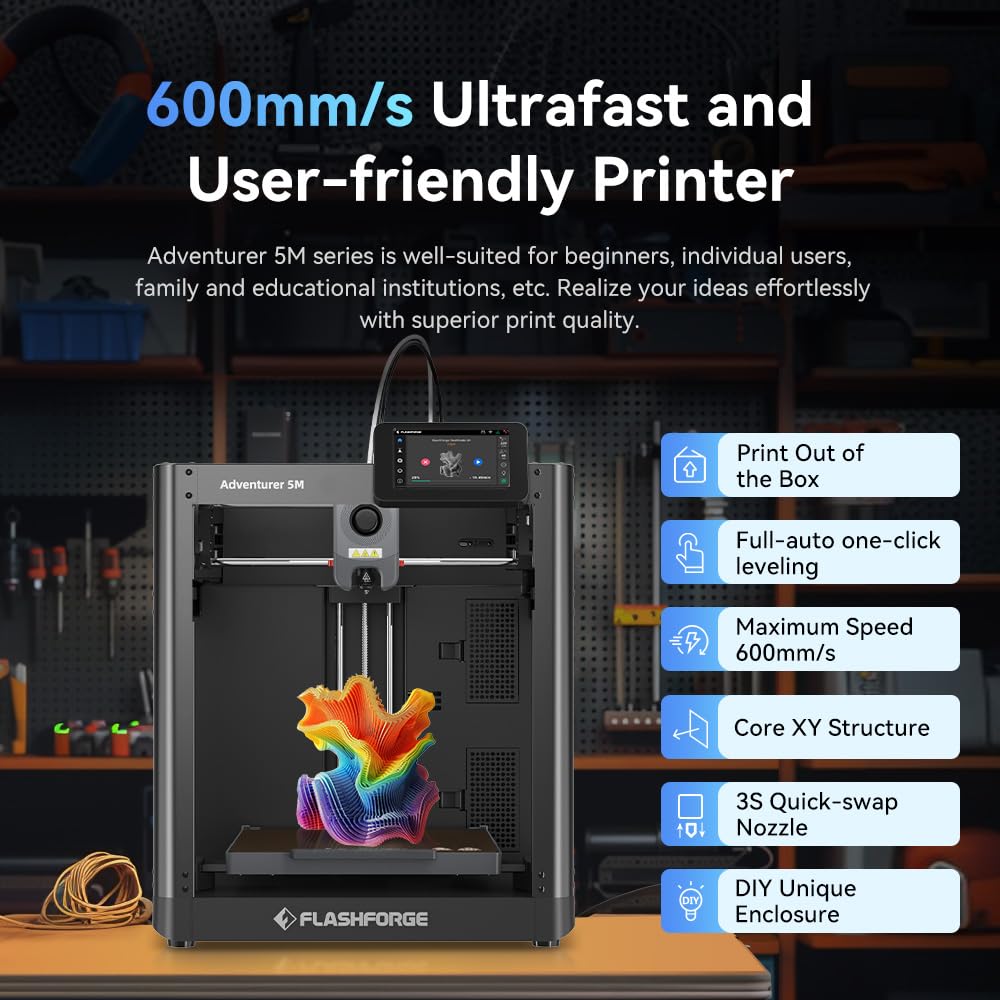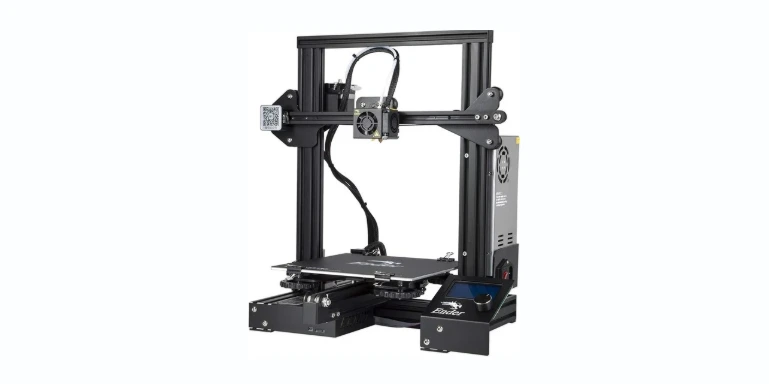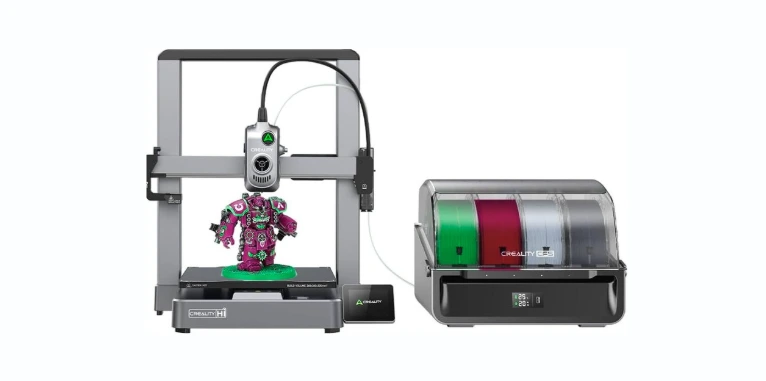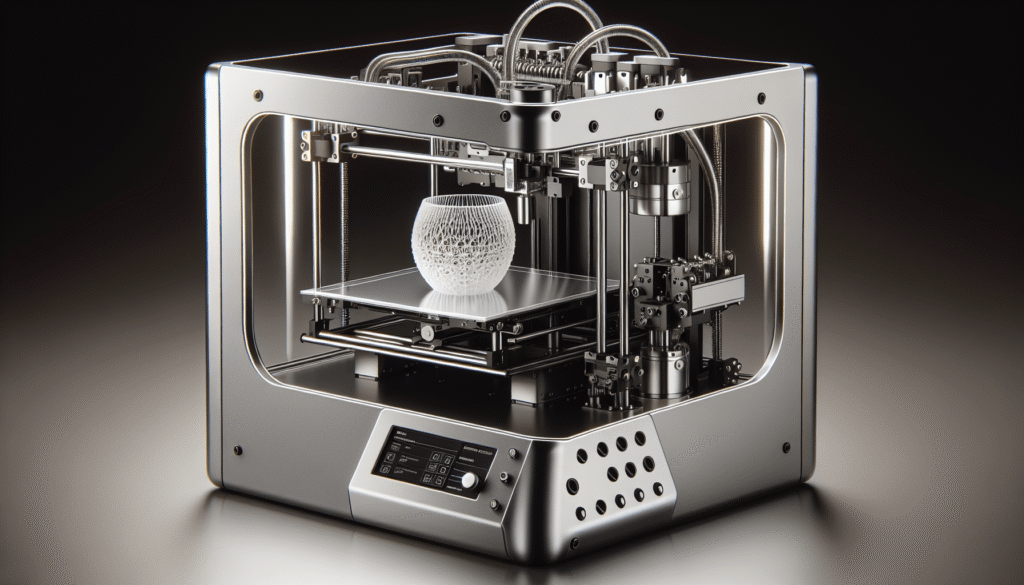Have you ever met a machine that instantly makes you feel both smarter and less necessary?
Why I Chose the FLASHFORGE Adventurer 5M
I wanted a 3D printer that wouldn’t punish me for being human. The FLASHFORGE Adventurer 5M promised speed, sanity, and a first layer that didn’t need prayer or profanity. That combination felt like a small miracle, and I was curious to see if it would hold up in my chaotic, coffee-fueled life.
I’ve owned printers that required me to behave like a delicate monk, hovering around with spirit level and hex keys, adjusting the Z-offset like it was a violin. This one promised a fully automated experience. If you’re anything like me—optimistic, impatient, and surprisingly fond of pressing “go”—that’s a tempting offer.
FLASHFORGE Adventurer 5M 3D Printer with Fully Auto Leveling System, Max 600mm/s High-Speed, 280℃ Quick-Detach Nozzle, CoreXY Structure for Superior Print Quality, Rookies & Experts Smart Choice
The Big Promise: A Stress-Free Printer for Rookies and Pros
I’m not new to 3D printing, but I’m not trying to live in a workshop either. The Adventurer 5M is pitched as a smart choice for both beginners and experienced users, and I love when a product refuses to punish new people or insult the veterans. It shows up with the confidence of a machine that knows it can handle both.
The brand talks about “new technology and craftsmanship,” and while I’m allergic to buzzwords, the experience backs it up. The printer cuts out rituals I used to accept as part of the hobby, and it does so without stripping away control for those of us who like to tweak.
Unboxing and First Impressions
When I lifted it out of the box, it had that sturdy, purposeful look that says, “I’m not a toy, but I am fun.” The build feels solid and clean, with an all-metal motion system tucked inside a design that won’t make your living room look like a factory annex.
I like machines that seem like they were put together by someone who actually used them. This one has that feel—screws where you want them, panels that don’t rattle, and a carriage that glides like it knows what it’s doing.
CoreXY Structure: Speed Without the Jitters
The Adventurer 5M uses a CoreXY motion system, which is one of those terms that sounds like fitness equipment but actually just means it moves fast and accurately. In practice, it reduces the thrashing that can sabotage print quality at high speeds. The result is quick motion without a lot of wobble or weirdness.
That structure pairs with an all-metal motion assembly, so the hardware doesn’t flap around like a tent in a storm. It feels tuned for speed, and not just speed for the spec sheet—useful speed, the kind that still results in objects you can actually use.
From Box to Print: Setup That Doesn’t Punish You
I put the printer where I always put new machines: in the one clear corner of my desk that isn’t swallowed by notebooks and coffee mugs. Plugging it in and getting it connected was painless, and I was printing within an unembarrassing amount of time. That alone puts it ahead of my previous experiences.
There’s no mechanical gauntlet to run. No ritualized Z-axis shimmy. No incantations whispered to a glass bed. The printer wants you to print, not to prove that you deserve to.
Fully Automatic Leveling That Actually Works
The star of the setup is the fully automatic one-click leveling. The printer measures the distance from the nozzle to the build plate, figures out the proper offsets, and then applies them. I pressed a button, went to get tea, and came back to something that looked like competence personified.
I didn’t need loupe, feeler gauges, or the noble art of squinting. The Z-axis calibration is hands-off, and I didn’t touch a leveling knob because there aren’t any. The first layer was so consistent it made me suspicious, the way I get when I find cash in an old coat.
The Nozzle: Quick-Detach Magic at 280°C
There’s a moment in every print hobbyist’s life where a clog forces them to take apart something they shouldn’t. The Adventurer 5M offers an antidote: a quick-detach nozzle that changes without tools in about three seconds. I popped it out like a battery and slotted in another. It felt indecently satisfying.
The nozzle can hit up to 280°C, which is great for most of the materials I actually use. Better yet, the printer supports nozzle diameters of 0.25, 0.4, 0.6, and 0.8 mm, letting me prioritize either detail or speed. For small, fussy parts, I used the 0.25 mm. For big brackets and anything with the words “just finish it,” the 0.6 or 0.8 mm had my back.
Speed Without Regret: Up to 600 mm/s
Here’s where the machine gets spicy. The Adventurer 5M can hit speeds up to 600 mm/s, which is like watching your old printer’s life flash before its eyes. The difference is that this one remains civilized when it’s moving quickly. Prints that used to be a weekend project have become coffee-break events.
This is where the CoreXY layout matters. Fast motion without lots of heavy parts moving in unfortunate directions means less ringing and better accuracy. I’ve seen some printers sprint like a toddler in a museum—fast but constantly in danger. This one feels like a runner who knows the route.
Noise and Behavior in Real Life
I care about sound because I also care about my sanity. In high-speed mode, the Adventurer 5M is surprisingly quiet—more of a measured hum than a mechanical tantrum. I could listen to a podcast while it worked, which is my personal benchmark for acceptable noise.
I also noticed less vibration than expected at high speeds. I didn’t see the kind of ghosting that ruins clean surfaces. If I really pushed the acceleration, I could coax some artifacts out of it, but under normal, sane settings, it behaved.
Smart Control: Orca-Flashforge Slicer and Flash Maker App
I used the Orca-Flashforge slicer for most of my prints, and it felt intuitive without being obvious about it. It supports one-click group file sending and monitoring across multiple printers, so if you’re running a small print farm—or pretending to—you’ll appreciate that. It’s the scheduler I always wanted in my old setup.
The Flash Maker app let me monitor jobs remotely, adjust parameters, and generally check in on things like a nervous parent. I could see status in real time, which saved me a walk across the house that I wouldn’t have taken anyway. It’s the kind of smart support that makes you feel like you can leave the room without returning to a spaghetti sculpture.
Printing After Power Outages: A Sensible Safety Net
I live in a neighborhood where the power likes to flirt with chaos. When the lights drop, I usually say goodbye to any ongoing project. The Adventurer 5M saved my layer progress during one such incident and resumed without a fuss when power returned. I sat there waiting for drama, and none arrived.
That kind of graceful recovery isn’t just convenient; it’s psychologically soothing. It’s the appliance equivalent of a friend who remembers where you were in the story and just keeps going.
The Build Plate: PEI Steel, Double-Sided, and Forgiving
I’m fond of build plates I can flex like a dinner tray. The flexible, double-sided PEI steel plate let me bend and release prints without scraping like a medieval blacksmith. It’s coated differently on either side, with the reverse side designed specifically for PETG. That little touch made me feel seen.
Adhesion was reliable. Not so aggressive that I had to pry with a spatula, not so timid that prints slid around mid-job. I’m a believer in PEI for sanity, and this implementation reinforced that faith.
Real Prints, Real Results
I do my usual set of tests: a Benchy, a calibration cube, some miniature parts to punish small features, and one large, functional piece that exposes warping and layer consistency. The Adventurer 5M handled all of them like it had nothing to prove. The Benchy went from plastic coil to finished boat before I finished an email.
Layer lines were tidy, the seams behaved, and corners didn’t bulge with the guilty look of bad acceleration tuning. Surfaces on curved parts were clean enough that I felt a little smug showing them off to friends who would rather not hear about 3D printing at all.
Material Choices and Temperature Reality
With a nozzle capable of 280°C, I stuck to the classics: PLA, PETG, and TPU. Each worked without drama, especially with the right nozzle and the appropriate side of the build plate. PETG in particular bonded confidently to the reverse plate surface, as intended.
If you’re dreaming of exotic, high-temp filaments, just remember that temperature cap. For the majority of everyday projects—brackets, organizers, toys, prototypes, small functional parts—this temperature range is perfectly adequate. I didn’t feel constrained unless I was imagining an industrial scenario that belongs in a lab.
Suitability for Beginners: No Gatekeeping Required
If you’re new, this machine feels like a friendly tutor who doesn’t judge. No leveling tools, no Z-axis calibrations by hand, no fragile first layer that determines your entire mood. You press a button, and it genuinely does the setup for you.
I’ve watched beginners get defeated by a printer that offered them too much rope. The Adventurer 5M is the opposite. It gives you a good start by default and then steps back when you’re ready to take more control. That curve matters.
Suitability for Experienced Users: Options Without Drama
If you’ve already burnt your fingers and your patience in this hobby, you’ll appreciate the speed, the motion system, and the nozzle flexibility. The quick-detach nozzle turns experiments into a casual decision instead of a wrench-laden event. The slicer gives you the usual knobs to turn, and the network features make multi-printer life much easier.
I like a machine that doesn’t insist on being “simple” at the expense of capability. This one feels respectful of tinkerers without demanding that everyone become one.
The Adventurer 5M in Daily Life
The best thing I can say is that I didn’t have to think about it. I loaded jobs, checked my phone once or twice, and returned to find finished prints sitting there like they’d always existed. I wasn’t hunched over it, tuning, pleading, and starting again. That’s a big shift for me.
I was able to work it into my day the way I would a regular tool: the equivalent of a toaster I trust. I don’t have to babysit a toaster. I press the lever and go butter the counter like a fool.
Where It Fits in the Market
I’ve tried faster printers, pricier printers, and printers that cost less but somehow charge me in patience. This one hits a sweet spot for people who want fast, clean results without jumping fully into an ecosystem that feels like a walled garden. It respects your time whether you have one printer or five.
The big headline features—600 mm/s speeds, CoreXY, fully automatic leveling, quick-detach nozzles, app control—aren’t just there to impress. They actually make the experience calmer. That “rookies and experts” line isn’t just marketing, it feels accurate.
Table: Key Features and My Experience
I like a clean breakdown, so here’s the summary I wish I’d had before I bought it.
| Feature | What It Is | Why It Matters | My Experience |
|---|---|---|---|
| Fully automatic one-click leveling | Measures nozzle-to-bed distances and sets offsets automatically | No manual Z calibration or tools required; first-layer success | Reliable, consistent first layers with zero tinkering |
| CoreXY all-metal motion system | Stiff, fast motion architecture | High-speed prints with less vibration and better quality | Quick and clean surfaces, minimal ghosting under sane settings |
| Max 600 mm/s speed | Top-end printing velocity | Rapid production without losing quality | Real-world time savings on bigger pieces |
| Quick-detach nozzle up to 280°C | Tool-free nozzle changes in ~3 seconds | Easy maintenance; swap diameters for detail or speed | Genuinely fast changes; I swapped often without dread |
| Multiple nozzle sizes | 0.25 / 0.4 / 0.6 / 0.8 mm options | Precision vs throughput flexibility | 0.25 for minis; 0.6+ for functional parts—worked great |
| Orca-Flashforge slicer | Full-featured slicer with network support | One-click group file sending and multi-printer monitoring | Smooth workflow; good presets and easy management |
| Flash Maker app | Remote control and monitoring | Real-time status, parameter tweaks anywhere | Reduced babysitting; helpful when away from the desk |
| Power-loss recovery | Saves last layer during outage | Protects long prints from sudden failures | Worked flawlessly in one real incident |
| Double-sided PEI steel plate | Flexible plate with PETG-optimized reverse side | Easy removal and tuned adhesion | No scraping drama; PETG adheres properly on the right side |
| Beginner-friendly setup | Minimal assembly and touch-free leveling | Lower barrier to entry | Got to first print fast without headaches |
Print Quality Under Pressure
I asked a lot of this printer. I pushed layer heights down for detail and up for speed. I turned on infill patterns that make my laptop fan spin harder than necessary. Through all of it, the Adventurer 5M kept its composure. Edge accuracy was solid, and small features were crisp within reason for each nozzle size.
There’s always a trade-off at 600 mm/s, and physics hasn’t changed. But at realistic speeds—fast, not feral—the results looked like something I’d happily hand someone without apologizing.
The Joy of Swapping Nozzles
I didn’t think I would switch nozzles this often, but when it’s effortless, I do it. Being able to move from 0.4 mm to 0.6 mm for a quick functional job without bringing out a toolkit makes the whole process more fluid. I found myself matching nozzle to project instead of settling for whatever was installed.
That’s how the printer quietly boosts my creativity: by removing the friction points. I’m more likely to start a print if I know it won’t become a whole afternoon of tinkering.
Software That Feels Like a Partner
Orca-Flashforge is not a stripped-down, “beginner only” slicer. It gives you profiles that work well and gets out of the way. The network features let me send a batch of files to one or more printers in a single shot. It’s the kind of software that supports your ambition instead of rinsing it out of you.
The Flash Maker app is especially handy when a long print is going and I’ve got other things to do (which is always). I liked seeing temperature and progress in real time and nudging speeds or temps slightly if I needed to, without running upstairs to perform a ritual dance.
Maintenance: Minimal and Merciful
I kept up with reasonable maintenance: wiped the nozzle, checked the bed, and occasionally cleaned the build plate. The all-metal motion structure stayed quiet and didn’t demand fealty or tuning ceremonies. The quick-detach nozzle made it easy to swap and soak if something felt off.
I didn’t spend my weekends re-tensioning belts and sipping lukewarm misery. That alone feels like progress.
Reliability Over Weeks of Use
After several weeks, I trust it. Jobs finish. The bed stays flat. The first layer remains a point of pride and not an unending negotiation. The machine carries itself with the kind of quiet confidence that makes me forget the horror days when I would watch a print like a doctor on a beeping monitor.
If you’re building an environment where prints are part of your life or business, that consistency means more than any single benchmark.
Pros and Cons as I Lived Them
I reward honesty, so here’s mine: I really like this printer, but nothing is flawless.
-
Pros:
- Truly automatic leveling that works
- Legitimately fast with good quality thanks to CoreXY
- Nozzle swaps are glorious and fast
- PEI plate is forgiving and practical
- App and slicer make multi-printer life easier
- Power-loss recovery is dependable
-
Cons:
- The 280°C limit may be restrictive if you’re chasing high-temp exotica
- At absolute max speeds, some artifacts appear (as expected)
- Ecosystem features may feel more useful if you fully embrace their software stack
Who Should Pick This Printer
If you want something that simply works, and you want it to work quickly, this is for you. Whether you’re starting out or stepping up, the features hit that sweet spot of competence and convenience.
If you’re the person who prints all weekend and runs two or three machines, the group sending and network monitoring will quietly get their hooks into you. If you’re the person who prints once a week and just wants it done, the automation is your ally.
What I Printed and Why It Mattered
I printed a phone stand because I hate how they look in stores and because I enjoy pretending my version is superior. I printed cable clips to reduce the visible chaos of my desk. I printed a toy octopus for a child who was too polite to ask why it had eight arms and a smirk.
On the more practical side, I printed a replacement bracket for a closet rod, and it fit on the first try. Clean corners, consistent walls, and minimal fuss. If you’ve ever held a functional print and thought, “This doesn’t look like it will snap in a week,” you’ll know that small thrill.
Learning Curve Moments I Didn’t Expect
I discovered that at high speeds, it pays to keep your expectations realistic about surface finish. Fast prints can be perfectly usable, but for showpieces, I slowed things down. The printer handled both ends of that spectrum gracefully.
I also learned that with PETG, using the correct side of the PEI plate matters more than pride. The reverse side tailored for PETG genuinely adheres better and releases on flex without tearing out chunks of my soul.
My Tips for Getting Great Results
- Let the automatic leveling handle the heavy lifting. Don’t override it unless you have a reason.
- Keep a couple of nozzles on hand and swap based on the job. You’ll save time when you stop forcing a 0.4 mm to be everything.
- For PETG, use the reverse plate and go slightly slower for crisp walls.
- Use the app to keep tabs on long jobs. It’s the difference between confidence and anxiety.
- If you push the speed to the moon, lower acceleration a touch to keep corners neat.
Everyday Joys That Add Up
I didn’t realize how much I would love the little things: prints that pop off the plate like they want to be free, layers that look like they actually like each other, a nozzle that doesn’t turn into a personality test. The printer made me feel productive without feeling like a lab assistant.
I even started queuing prints before breakfast. One small thing, done well, spills over into the rest of the day.
The Non-Technical Bit That Still Matters
There’s a mood that good tools create. It’s a mixture of confidence and lack of friction. This printer gave me that feeling. I didn’t feel like I had to justify it, or fight it, or study it for hours. I just used it, frequently and happily.
That’s the secret win: it makes me want to make things. The less I think about the tool, the more I think about the project, which is how it should be.
If You’re Upgrading from an Older Printer
You’ll feel the difference immediately in the first layer and the speed. The automation is night-and-day if you’re moving from a bed-slinger that needed constant love. The CoreXY structure keeps things crisp when you go faster, and you’ll stop having to explain to people why that funny ripple on the side is “totally normal.”
The quick-detach nozzle will make you wonder how you ever lived without it. Especially if you used to wrestle with tiny wrenches and a newfound respect for heat-resistant fingertips.
If This Is Your First Printer
You picked well. You’ll print sooner, succeed more often, and not learn a bunch of bad habits that revolve around compensating for machines that don’t want to help you. You can still get nerdy with settings later if you want to, but you won’t be forced into it as a survival tactic.
You’ll also learn something important: a good first layer is worth more than any talent show. This machine gives you that from the jump.
The Part Where I Admit What Surprised Me Most
I didn’t expect to use the remote monitoring as much as I did. It seemed like a novelty until I had a six-hour job running and errands to run. Seeing the progress bar on my phone kept me from that “what if it’s making abstract art” anxiety I’ve grown accustomed to.
I also didn’t expect the build plate to be as drama-free as it was. I’ve polished other plates like they were antique silver and still fought prints for custody. This one just worked.
Where the Adventurer 5M Saves You Time
- Leveling and first-layer rituals: gone.
- Nozzle changes: quick and clean.
- Remote monitoring: no more hovering.
- Group file sending: spare yourself the USB shuffle.
- Easy plate removal: no chisel, no prayer, no regret.
That time gets spent making more things or simply moving on. Either way, it’s a win.
A Few Real-World Quirks
When you push it to maximum speed with aggressive acceleration, you’ll get the usual ringing. That’s physics, not negligence. I also found that PETG strings a bit if I rush the retraction settings—again, normal, and easy to tune.
The 280°C ceiling is honest and realistic for most use cases, but if your heart is set on high-temp nylon blends or other exotics, you’ll need to consider that limit. For everyday makers, it’s not a dealbreaker; for niche materials, it matters.
Longevity and Care
I didn’t have any mechanical surprises, and I expect it to last with the usual respect: keep the plate clean, don’t grind your filament drive with questionable spools, and treat the nozzles like lightbulbs—replace, don’t overthink. The all-metal motion structure inspires confidence, and the machine doesn’t creak or gasp under pressure.
If you’ve lived through the kind of printer that loosens itself into a new personality every month, this one will feel refreshingly consistent.
What Makes the Adventurer 5M Different for Me
It removes the barriers to starting a print, and it removes the barriers to finishing one. The high-speed capability means I don’t hesitate to throw big jobs at it. The auto-leveling means every print doesn’t begin with a ritual. The nozzle system means I don’t dig out tools I don’t actually want to use.
All of that adds up to a printer that gets used a lot. Not because it’s flashy, but because it’s dependable.
Scenarios Where It Shines
- You’re making cosplay parts on a deadline and you want speed without a mess.
- You run a classroom or lab and need reliable starting conditions for everyone.
- You prototype household fixes and hate fiddling with Z offsets.
- You print for sale and want network control across multiple units.
- You’re impatient, in a lovable way.
Scenarios Where You Might Want Something Else
- You insist on materials that require sustained temperatures beyond 280°C.
- You want to customize every aspect of the machine’s hardware and firmware out of the box.
- You’re building a setup around a specific ecosystem with proprietary hardware across the board.
For everyone else, this is a well-balanced machine that behaves like a partner rather than a project.
The Short Version I Tell Friends
It’s fast, it’s reliable, and the first layer works without drama. The nozzle changes in seconds, the app is useful, and the parts look good. If you want to make things and keep your sanity, it’s a smart pick.
If that friend is a beginner, I say, “You’ll actually print.” If that friend is a veteran, I say, “You’ll print faster.”
Final Thoughts: Creativity Without Friction
The FLASHFORGE Adventurer 5M feels like it was designed by people who were tired of the same obstacles I was. It’s a genuinely beginner-friendly machine that doesn’t patronize experienced users. It’s fast enough to change my habits and reliable enough to earn a spot in my daily routine.
My favorite compliment for any tool is this: it disappears while I’m using it. This printer does that. I think less about the process and more about the object I’m making. And that’s when you know you’ve found the right machine—the one that gets out of your way and lets your ideas take form, without requiring a sacrifice of time, patience, or fingertips.
If you’re ready for a printer that pairs high-speed capability with an actually stress-free setup, and if you value features that are more than a spec sheet victory lap—fully automatic leveling, a CoreXY motion system, a 280°C quick-detach nozzle, app control, and a double-sided PEI plate—you’ll find this one hard to beat. I certainly did.
And if the lights go out mid-print, it will remember where you were. It won’t panic. It will wait with the grace of a machine that knows exactly what it’s doing. Then, when the power comes back, it will start again, as if to say, “I’ve got this.” In my book, that’s the kind of confidence I want on my desk.
Disclosure: As an Amazon Associate, I earn from qualifying purchases.



